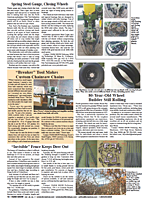Sea Farming Catching On
 ✖  |
Bren Smith saves seed and produces seedlings that he carefully plants and later harvests. Unlike most farmers, his fields are 20 acres off the coast of Connecticut. His polyculture system produces around 250,000 lbs. of kelp each winter, mussels in the spring, summer and fall, and oysters year-round.
“I grow seaweed alongside scallops in lantern nets and mussels in mesh socks all hanging from underwater rope scaffolding just below the surface of the ocean,” says Smith. “Staked below the seaweed are oysters in cages and clams buried in the sea floor. If one crop fails, I have others to fall back on.”
He notes that one of the best things about kelp farming is the availability and low cost of land. Smith explains that the local community controls nearshore ocean farming. As you go farther offshore, the state and eventually the federal government control it.
He pays the local community government $50 per acre for his 20-acre lease. The public has full access to the area except for harvesting the seaweed and shellfish.
“Some of the best fishing in the area is on my farm,” says Smith.
Smith’s farm season starts in the fall when kelp seed production kicks off in the nursery.
“We have spools of string in the nursery, and the kelp grows on it,” says Smith. “When it reaches about a centimeter, the seed strings are brought to the farm and unraveled around long ropes anchored in the ocean. It then grows vertically downward. Depending on the location, the farm can be from 6 ft. to 100 ft. deep.”
The deeper the water, the longer the ropes and the bigger the anchors, notes Smith. Unlike planting on land, the water is constantly being renewed. He’s been farming kelp on the same 20 acres for 19 years with no need to fertilize or pay for any other inputs. Smith estimates that anyone with $30,000, a boat and 20 ocean acres could start a farm.
Helping others farm the ocean is why he founded GreenWave, a North American nonprofit dedicated to training and supporting others to farm as he does. What started as an effort to share his ideas with a few friends became a tsunami when it went viral.
“I was training 8 to 10 people a year through GreenWave,’ says Smith. “When I set up a website to offer the training, we had 8,000 people from the U.S. and more than 100 countries sign up.”
Thanks to grants and donations from major companies, foundations, government agencies and member organizations, GreenWave has become an educational hub. By leveraging a mix of farmer-forward training and support, as well as infrastructure and market development, GreenWave partners with coastal communities to replicate and scale the regenerative ocean farming model.
GreenWave also operates a seed bank and nursery, growing the majority of kelp seed for farmers in southern New England. The organization’s farm and nursery serve as both a commercial farm and an innovation hub, where new designs and technologies are tested.
“Our online community now numbers more than 8,000 people, from early-stage and advanced farmers to scientists and seed producers to other seaweed organizations and entrepreneurs, sharing information and learning together,” says Smith.
The free online training includes 30 courses, featuring over 100 videos and more than 110 lessons on launching and scaling an ocean farm business.
GreenWave also offers several resources for experienced seaweed farmers. Seaweed Source is a free app, helping seed producers, farmers and buyers discover new partners in the industry and initiate forward contracts. The Kelp Climate Fund pays seaweed farmers for the environmental benefits their farms provide. Farmer Forum is a series of virtual and in-person gatherings around seasonally relevant topics.
To date, over 8,000 users are tapped into the free Regenerative Ocean Farming Hub training, tools and community. The Kelp Climate Fund supports 77 farms across 11 states and provinces in the U.S. and Canada. They’ve planted over 300 miles of kelp seed string and harvested 3.1 million lbs. of kelp. Ninety-eight companies from 19 states have signed up on Seaweed Source.
Until recently, U.S. and Canadian seaweed farmers struggled to compete with low-cost producers in Asia. But Smith believes that’s changing.
“As wages rise and outdated systems fall behind, there’s an opening for North American farmers to lead with regenerative, modern methods,” he says.
Contact: FARM SHOW Followup, GreenWave (www.greenwave.org).

Click here to download page story appeared in.
Click here to read entire issue
Sea Farming Catching On
Bren Smith saves seed and produces seedlings that he carefully plants and later harvests. Unlike most farmers, his fields are 20 acres off the coast of Connecticut. His polyculture system produces around 250,000 lbs. of kelp each winter, mussels in the spring, summer and fall, and oysters year-round.
“I grow seaweed alongside scallops in lantern nets and mussels in mesh socks all hanging from underwater rope scaffolding just below the surface of the ocean,” says Smith. “Staked below the seaweed are oysters in cages and clams buried in the sea floor. If one crop fails, I have others to fall back on.”
He notes that one of the best things about kelp farming is the availability and low cost of land. Smith explains that the local community controls nearshore ocean farming. As you go farther offshore, the state and eventually the federal government control it.
He pays the local community government $50 per acre for his 20-acre lease. The public has full access to the area except for harvesting the seaweed and shellfish.
“Some of the best fishing in the area is on my farm,” says Smith.
Smith’s farm season starts in the fall when kelp seed production kicks off in the nursery.
“We have spools of string in the nursery, and the kelp grows on it,” says Smith. “When it reaches about a centimeter, the seed strings are brought to the farm and unraveled around long ropes anchored in the ocean. It then grows vertically downward. Depending on the location, the farm can be from 6 ft. to 100 ft. deep.”
The deeper the water, the longer the ropes and the bigger the anchors, notes Smith. Unlike planting on land, the water is constantly being renewed. He’s been farming kelp on the same 20 acres for 19 years with no need to fertilize or pay for any other inputs. Smith estimates that anyone with $30,000, a boat and 20 ocean acres could start a farm.
Helping others farm the ocean is why he founded GreenWave, a North American nonprofit dedicated to training and supporting others to farm as he does. What started as an effort to share his ideas with a few friends became a tsunami when it went viral.
“I was training 8 to 10 people a year through GreenWave,’ says Smith. “When I set up a website to offer the training, we had 8,000 people from the U.S. and more than 100 countries sign up.”
Thanks to grants and donations from major companies, foundations, government agencies and member organizations, GreenWave has become an educational hub. By leveraging a mix of farmer-forward training and support, as well as infrastructure and market development, GreenWave partners with coastal communities to replicate and scale the regenerative ocean farming model.
GreenWave also operates a seed bank and nursery, growing the majority of kelp seed for farmers in southern New England. The organization’s farm and nursery serve as both a commercial farm and an innovation hub, where new designs and technologies are tested.
“Our online community now numbers more than 8,000 people, from early-stage and advanced farmers to scientists and seed producers to other seaweed organizations and entrepreneurs, sharing information and learning together,” says Smith.
The free online training includes 30 courses, featuring over 100 videos and more than 110 lessons on launching and scaling an ocean farm business.
GreenWave also offers several resources for experienced seaweed farmers. Seaweed Source is a free app, helping seed producers, farmers and buyers discover new partners in the industry and initiate forward contracts. The Kelp Climate Fund pays seaweed farmers for the environmental benefits their farms provide. Farmer Forum is a series of virtual and in-person gatherings around seasonally relevant topics.
To date, over 8,000 users are tapped into the free Regenerative Ocean Farming Hub training, tools and community. The Kelp Climate Fund supports 77 farms across 11 states and provinces in the U.S. and Canada. They’ve planted over 300 miles of kelp seed string and harvested 3.1 million lbs. of kelp. Ninety-eight companies from 19 states have signed up on Seaweed Source.
Until recently, U.S. and Canadian seaweed farmers struggled to compete with low-cost producers in Asia. But Smith believes that’s changing.
“As wages rise and outdated systems fall behind, there’s an opening for North American farmers to lead with regenerative, modern methods,” he says.
Contact: FARM SHOW Followup, GreenWave (www.greenwave.org).
To read the rest of this story, download this issue below or click
here to register with your account number.







